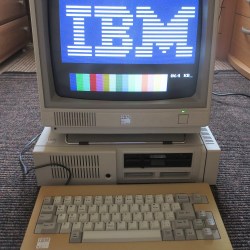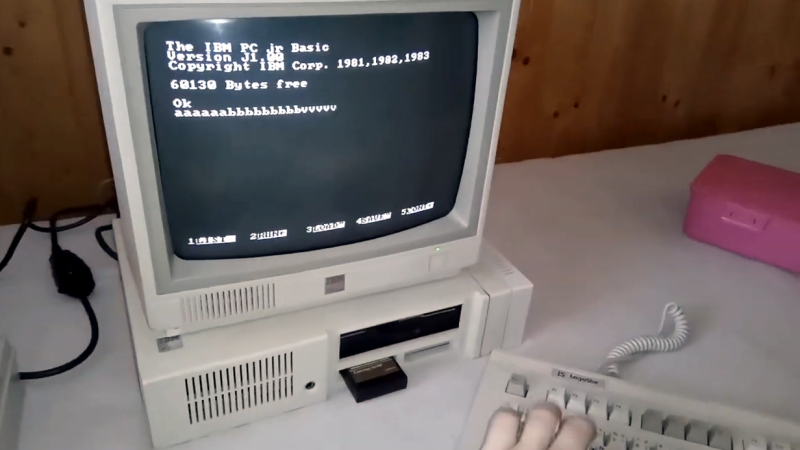Most of us think of keyboards — even vintage ones — as being fairly standardized and interchangeable, but that isn’t the case for the IBM PCjr. Its keyboard was quite unlike most others of its time, which means that a PCjr without an original keyboard is pretty much a dust collector. That’s what led [Jozef Bogin] to create the KeybJr, a piece of hardware that allows one to use any AT, XT, or PS/2 keyboard with the IBM PCjr.

What was strange about the PCjr’s keyboard? From the outside it looked pretty normal, but it definitely had its own thing going on. For one, the PCjr keyboard operated over a completely different protocol than the other keyboards of the time. In addition, its connection to the host was either by IR, or via its own wired cable adapter.
The KeybJr solves this by using an Arduino-based board to turn inputs from other keyboards of the time into something the PCjr expects. These signals are sent out and received either over infrared, or by the PCjr’s “K” port for a wired keyboard link.
Why bother with the IR functionality? Well, the connector and pins on the PCjr are not very rugged, and sometimes they are damaged. In those cases, it is nice to have the option of using a normal (for the time) keyboard over the IR link. Vintage hardware is not always in perfect shape, after all. That’s why things like ATX power supply adapters for the PCjr exist.
Want to give it a shot? There is a GitHub repository for the KeybJr, and you can see it in action in a brief video, embedded below.
















I remember the scorn heaped upon the PCJr keyboard for being a “chiclet” one. Fast-forward to the mid-2010s, when Apple sold five years’ worth of computers with keyboards that were far inferior not only to the PCJr’s, but nearly to a Sinclair’s or an Atari 400’s.
Yep. Even brand new Dell computers come with those nauseating chicklet type of keyboards.
Although the Chicklet keyboard was ugly, it was very versatile and had an excellent feel.
The squared key design was a way to allow paper templates to be placed over (really around) the keys.
There was a lot of educational software that used these templates. Games too.
What a lot of people that liked to hate IBM at the time don’t know – is that IBM GAVE everyone with a Chicklet keyboard a FREE replacement keyboard with more common looking keycaps and even better feel.
The real problem with PCjr was IBM’s internal politics that delayed the line’s announcement (and shipping) for more than a year. Besides that, the FCC class “B” rating enforcement changed, so each unit had to be un-boxed and disassembled (and back) so the plastic case could be coated with (really expensive) silver paint. IBM also purposely crippled the BIOS to limit its memory capacity – requiring a special DOS driver to expand it.
I wrote some games for the Jr. One was a pretty good Missile Command clone. The multi-voice sound, and built in support for buttons and joysticks made the program surprisingly simple and small (20 long-convoluted lines of BASIC)
The computer could have been a great success; but IBM had no appreciation for the PC at the time and gave up quickly.
(From a guy on the IBM “Save the Junior” Committee back in the day.)
I was given a PC Jr in a pile of other stuff. Even had two extenders on the side, I recall an RTC and parallel port. But no keyboard. It sat around for a while, then I gave up. Not sure I really wanted it, but without a keyboard, couldn’t even try it. It was 1990.
Same thing happened with an HP-150. Found it lying on the street. Not sure what it was at that moment. Found the Byte with it on the cover, the computer and monitor in one unit. Csme out in 1984, a parallel to the Mac, except HP thought the future was touch screens. No keybosrd, so I couldn’t even use the built in terminal. And no way I’d spend on the needed floppy or hard drive.
Modern updates to old computers are always cool and useful. I’d like to point out some prior art from 2014, which is of course built on top of prior art from other projects: https://www.brutman.com/forums/viewtopic.php?t=415
Texelec is still selling a derivative of this project today: https://texelec.com/product/ibm-pcjr-joystick-and-keyboard-breakout-board/ ..
What was IBM thinking with the PCjr? Well anyway nice job keeping these rare machines going.